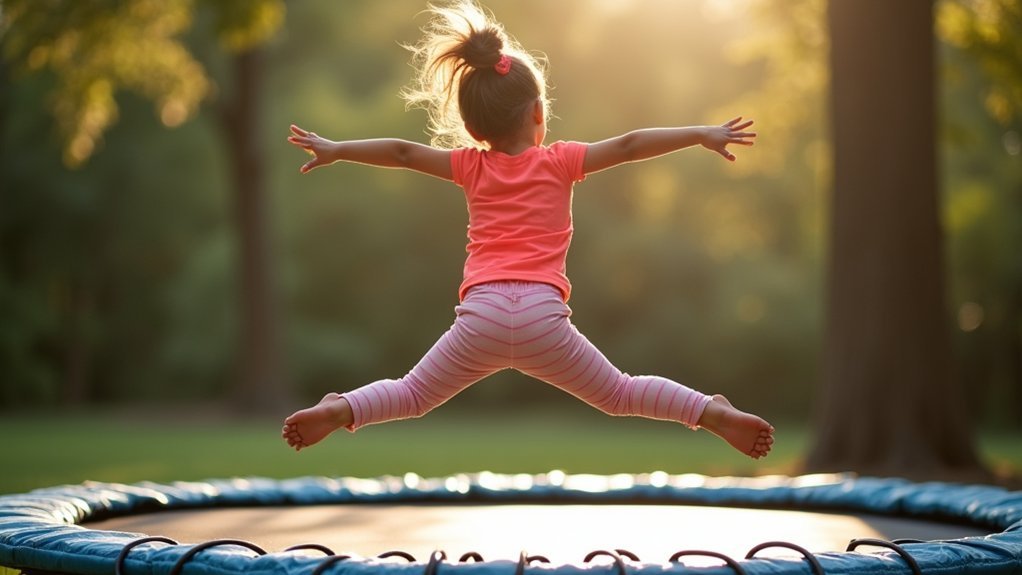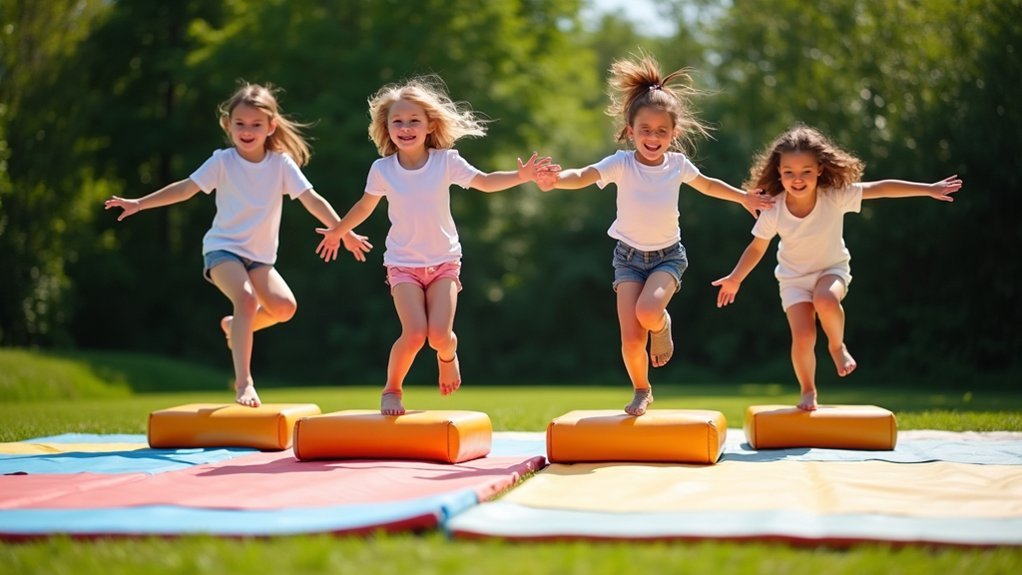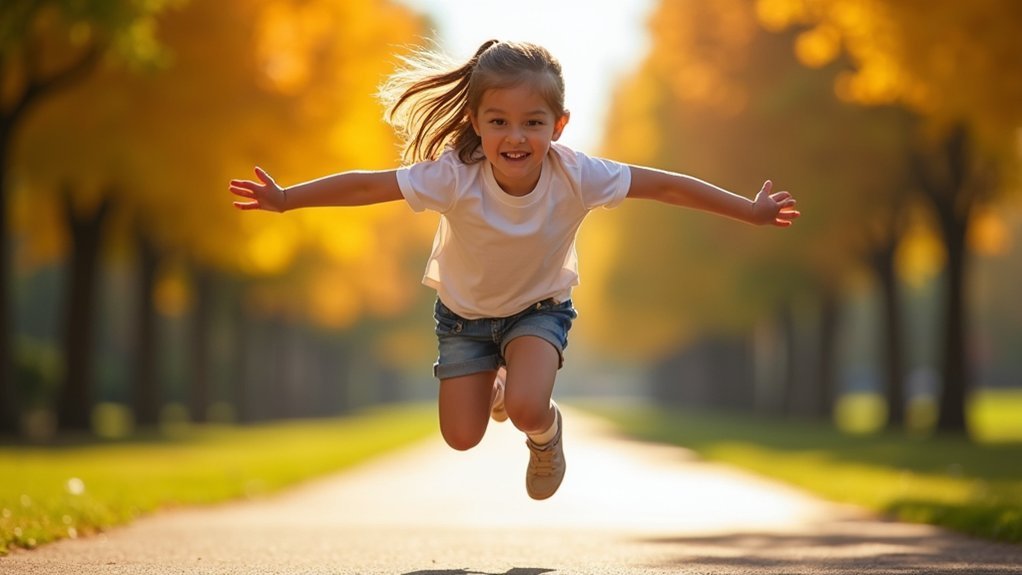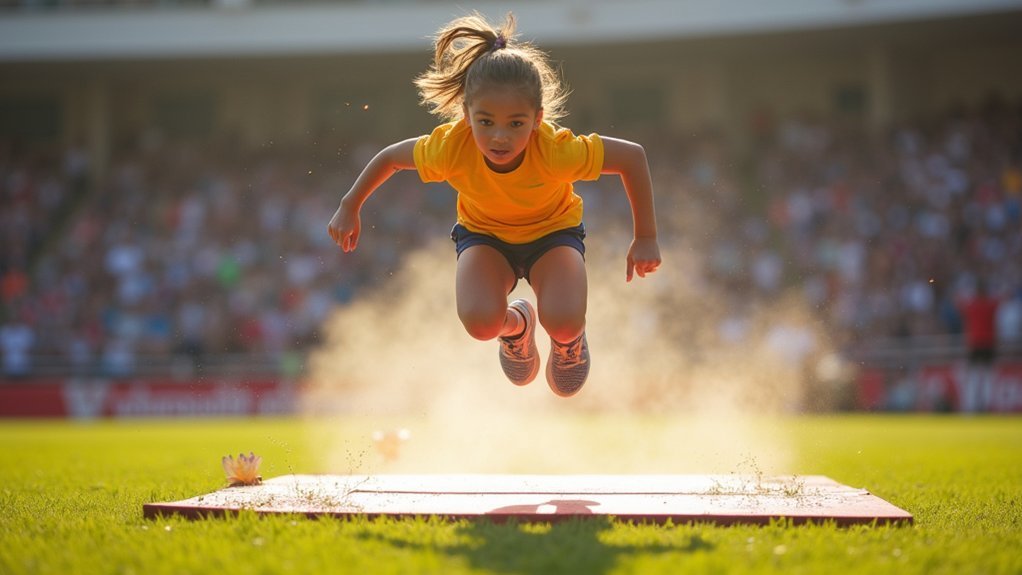Mini-jumps boost bilateral coordination by engaging both sides of your body simultaneously. Start with basic symmetrical bounces, then progress to alternating foot patterns and cross-body movements. Incorporate challenges like tossing bean bags from one hand to the opposite side while jumping, or reaching to touch your opposite foot. These activities strengthen neural pathways between brain hemispheres, improving balance, coordination, and focus. Set appropriate heights (12-24 inches) and use padded landing areas for safety. The following exercises will transform your child’s coordination abilities through consistent practice.
The Bilateral Benefits of Mini-Trampoline Exercises

While many exercise routines focus on isolated muscle groups, mini-trampoline workouts offer unique advantages for whole-body coordination. The rhythmic bouncing motion naturally engages bilateral coordination as your body works symmetrically to maintain balance and control.
Each jump activates your vestibular system, enhancing spatial awareness and refining motor skills essential for daily activities. The repetitive nature of mini-trampoline exercises strengthens muscles on both sides of your body simultaneously, promoting alternating movements vital for running and climbing.
Try adding challenges like catching a ball while jumping to improve hand-eye coordination and integrate dominant and stabilizing side movements.
For children, these activities are particularly valuable, building confidence in their physical abilities that transfers to sports and everyday tasks.
You’ll notice improvements in overall balance, coordination, and bilateral movement patterns with consistent practice.
Setting Up a Safe Mini-Jump Environment for Coordination Activities
Setting up your mini-jump at the appropriate height guarantees children can practice bilateral movements without unnecessary strain or risk.
The jumping surface should be surrounded by padded landing areas to cushion falls and protect developing joints during coordination activities.
You’ll want to adjust these safety features based on your child’s skill level, gradually increasing height as their bilateral coordination improves.
Safe Height Settings
Creating a safe mini-jump environment begins with proper height adjustments that match your child’s developmental stage. For ideal safety during coordination activities, set your mini-jump between 12 to 24 inches high—lower heights for beginners and gradually increasing as bilateral coordination skills develop.
Always place a soft landing surface beneath the mini-jump to cushion landings and prevent falls.
You’ll need to secure the mini-jump firmly to prevent shifting during use, either by anchoring it to the floor or using non-slip materials underneath.
Don’t forget to supervise children closely during jumping activities, especially those still mastering coordination.
Before each session, check the equipment for wear and tear, ensuring all components remain secure and functional.
Regular inspection prevents accidents and maintains the mini-jump’s integrity for continued safe development.
Padded Landing Areas
Properly designed landing surfaces form the heart of a safe mini-jump environment. Your child’s coordination skills flourish when you create generously padded landing areas that extend beyond the mini-jump’s footprint.
Use thick, soft mats or foam padding to absorb impact and protect against falls, allowing children to focus on mastering bilateral coordination activities rather than fearing injury.
Keep landing zones clean and free of obstacles to prevent accidents and guarantee smooth shifts between jumps. This thoughtful setup builds confidence as children learn they can safely challenge themselves.
Remember to regularly inspect padding for wear and tear – maintaining these cushioned surfaces preserves their effectiveness over time. A well-maintained landing area transforms the mini-jump from a simple piece of equipment into a safe developmental playground.
Foundational Symmetrical Jumping Patterns for Beginners

Start with a basic trampoline bounce by standing with feet shoulder-width apart and gently pushing through both feet with equal force.
You’ll gradually increase height as you gain confidence, focusing on landing softly with bent knees while maintaining symmetrical foot position.
Building equal-force jumps requires mindful practice of weight distribution, ensuring you’re not favoring one side over the other as you develop this foundational bilateral skill.
Basic Trampoline Bounce Progression
When children first approach the mini-jump, mastering foundational symmetrical jumping patterns establishes essential bilateral coordination skills. Start with simple bounces where both feet leave the surface simultaneously, maintaining straight posture and using both legs equally for balance.
You’ll want to encourage rhythmic bouncing by counting aloud or playing music, which helps children develop timing and bilateral coordination. As they gain confidence, introduce dynamic elements like arm swings or mid-air claps that integrate upper body coordination with lower body movements.
Consistent practice of these symmetrical jumping patterns builds core strength while preparing children for advanced trampoline skills.
Remember to monitor their form throughout sessions, ensuring they maintain proper technique as they progress through increasingly challenging movements on the mini-jump.
Building Equal-Force Jumps
Once comfortable with basic bouncing, children need to focus on generating equal force through both legs simultaneously. This bilateral coordination forms the foundation for all advanced jumping skills.
Encourage symmetrical jumping patterns like bouncing straight up and down or hopping over a small obstacle to engage both sides of the body equally.
Place visual targets at varying heights to motivate equal-force jumps that promote cooperative action between left and right legs. These exercises enhance balance and stability while children develop essential body awareness.
Regular practice of foundational jumping skills on the mini-jump strengthens gross motor skills that transfer to other physical activities.
As children master equal pressure through both feet, they’ll develop the symmetrical movement patterns necessary for more complex jumping sequences later in their physical development.
Alternating Movement Challenges to Advance Bilateral Skills
While many children master basic jumping skills early on, developing more sophisticated bilateral coordination requires targeted challenges that engage both sides of the body differently. Alternating movements on a mini-jump can greatly enhance this skill as children learn to use one leg for jumping while the other stabilizes.
Try incorporating activities like one-foot hopping exercises that improve balance and body awareness. Games that combine jumping with clapping or ball tossing facilitate rhythmic patterns that develop motor planning abilities.
Set up simple obstacle courses where your child jumps over objects using alternating feet to strengthen connections between brain hemispheres and improve gross motor skills.
With regular practice of these challenges, you’ll notice improvements in your child’s coordination, balance, and confidence during physical activities, creating a foundation for more complex movement patterns.
Integrating Upper and Lower Body Movements on the Mini-Jump

As children gain confidence with basic jumping skills, true bilateral development emerges through coordinated upper and lower body movements on the mini-jump.
You’ll notice enhanced bilateral coordination when your child performs symmetrical activities like jumping while reaching upward with both arms. Encourage them to bounce while passing a ball from hand to hand, integrating alternating movements that engage both hemispheres of the brain.
Incorporate exercises that involve crossing midline—have them reach across their body while jumping to strengthen neural connections.
Rhythmic jumping patterns, where one leg leads while the other supports, mirror the leading and supporting hand movements needed for writing.
Try dynamic activities like jumping jacks on the mini-jump to boost body awareness and balance, further enhancing bilateral integration through purposeful, coordinated movement sequences.
Cross-Midline Activities That Enhance Neural Connections
When children engage in movements that cross the body’s midline during mini-jump activities, they’re actually building critical neural pathways between brain hemispheres.
Encourage your child to reach across their body to touch the opposite foot while jumping, strengthening bilateral coordination and enhancing neural connections.
Try having them toss bean bags from one hand to the opposite side of the mini-jump, promoting integration of both sides and improving body awareness.
These rhythmic movements develop fine motor skills essential for academic tasks like writing and reading.
Incorporate games where they must cross arms while bouncing or reach for objects positioned strategically around the trampoline.
You’ll notice improved focus and attention as these crossing midline activities become more natural.
Regular practice transforms not just physical abilities but cognitive functions too.
Measuring Progress and Adapting Mini-Jump Exercises for Different Abilities
Tracking your child’s bilateral coordination development requires systematic observation and thoughtful adjustments to mini-jump activities.
Create a skills checklist to monitor specific achievements, such as landing on both feet simultaneously or alternating leading legs with proper timing and fluidity.
Systematic tracking of bilateral coordination milestones reveals patterns in your child’s development and highlights areas needing additional support.
Adapt mini-jump exercises by varying jump heights or using different surfaces like soft mats or trampolines to match your child’s abilities while ensuring safety.
Incorporate visual cues or rhythmic sounds to enhance focus and help your child respond to specific instructions.
Encourage self-assessment after each session by asking what felt challenging or successful. This reflection builds body awareness and motivates progress.
Document improvements over multiple sessions to identify patterns in coordination development and determine when to increase difficulty levels.
Frequently Asked Questions
Can You Improve Bilateral Coordination?
Yes, you can improve bilateral coordination through targeted activities that engage both sides of your body simultaneously. Practice symmetrical movements, alternating patterns, and midline-crossing exercises to strengthen these essential motor skills.
How to Teach Bilateral Coordination?
To teach bilateral coordination, engage your child in symmetrical movements like clapping while jumping, alternating activities like jumping jacks, and exercises that use dominant and supporting hands. Include visual-motor challenges and obstacle courses too.
At What Age Does Bilateral Coordination Develop?
Bilateral coordination emerges as early as 6 months and progresses through childhood. You’ll notice your child developing these skills from infancy through age 7, with significant refinement occurring between ages 3-5.
What Is Bilateral Skill?
Bilateral skill is your ability to coordinate both sides of your body together effectively. It’s when you can use your left and right sides either simultaneously or alternately to complete tasks with proper coordination.
In Summary
You’ve now got the tools to transform your bilateral coordination through mini-jump exercises. As you’ve practiced these symmetrical patterns and cross-midline movements, you’ve built neural connections that benefit everyday activities. Keep challenging yourself by gradually increasing difficulty and tracking your progress. Your improved balance, coordination, and body awareness will extend far beyond your trampoline sessions. Stay consistent and watch your bilateral skills soar!





Leave a Reply